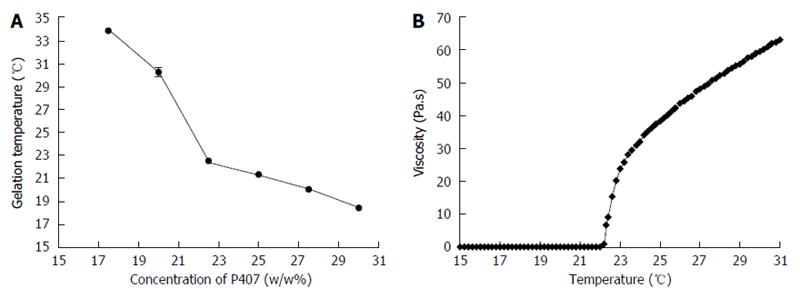Copyright
©The Author(s) 2017.
World J Gastroenterol. Mar 28, 2017; 23(12): 2141-2148
Published online Mar 28, 2017. doi: 10.3748/wjg.v23.i12.2141
Published online Mar 28, 2017. doi: 10.3748/wjg.v23.i12.2141
Figure 2 Optimal formulation.
A: Several concentrations of P407 were prepared. A stirring magnetic bar was used to determine the gelation temperature. When the magnetic bar stopped moving, the solution was considered gelled. The reliable data were defined three times in parallel (mean ± SD, n = 3). A negative correlation was observed between gelation temperatures and concentrations of P407. A 22.5% (w/w) P407 solution was found to gel at 22.3 °C; B: A Brookfield R/S+ rheometer with a spindle attached was used to study the viscosity of 22.5% (w/w) P407 solution. It was programmed to increase the temperature from 15 °C to 30 °C at a shear rate of 5/s. The viscosity was relatively low at temperatures below 18 °C and characterized as a fluidic state. Then, a sharp increase in viscosity was observed as an inflexion point was reached at sol-gel transition temperature (22.3 °C). By this time, it turned into a semi-solid.
- Citation: Zhang LL, Xia GM, Liu YJ, Dou R, Eisenbrey J, Liu JB, Wang XW, Qian LX. Effect of a poloxamer 407-based thermosensitive gel on minimization of thermal injury to diaphragm during microwave ablation of the liver. World J Gastroenterol 2017; 23(12): 2141-2148
- URL: https://www.wjgnet.com/1007-9327/full/v23/i12/2141.htm
- DOI: https://dx.doi.org/10.3748/wjg.v23.i12.2141









